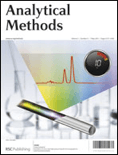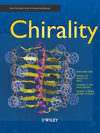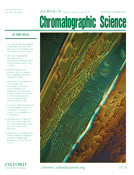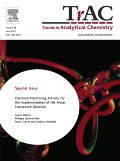
CHROMATOGRAPHIA
Scope & Guideline
Advancing the Frontiers of Chromatographic Science
Introduction
Aims and Scopes
- Development and Validation of Analytical Methods:
The journal consistently publishes studies that involve the development and validation of new chromatographic methods, particularly in high-performance liquid chromatography (HPLC) and gas chromatography (GC). These methods are often aimed at enhancing sensitivity, specificity, and speed in analyzing complex samples. - Application of Chromatography in Pharmaceutical Analysis:
A significant focus is on the application of chromatographic techniques for the analysis of pharmaceutical compounds, including the quantification of active ingredients, impurities, and degradation products in drug formulations. - Environmental and Food Safety Analysis:
Research published in CHROMATOGRAPHIA frequently addresses the use of chromatography in environmental monitoring and food safety, including the detection of contaminants, pesticides, and other harmful substances in food and water samples. - Innovation in Chromatographic Techniques:
The journal highlights novel approaches and advancements in chromatographic technologies, such as the use of new stationary phases, innovative extraction methods, and hyphenated techniques that combine chromatography with mass spectrometry. - Chiral Separations and Stereochemistry:
There is a notable emphasis on chiral separations, with studies focusing on the development of chiral stationary phases and methodologies for the analysis of enantiomers in pharmaceuticals and natural products.
Trending and Emerging
- Green Chemistry and Sustainable Practices:
There is a growing emphasis on environmentally friendly chromatographic methods, including the use of green solvents and sustainable practices in method development. This trend aligns with global initiatives aimed at reducing the environmental impact of analytical chemistry. - Integration of Artificial Intelligence and Machine Learning:
Recent publications are increasingly incorporating artificial intelligence and machine learning techniques for method optimization and data analysis in chromatography. This trend represents a significant advancement in the field, enabling more efficient and accurate analyses. - Advanced Hyphenation Techniques:
The combination of chromatographic techniques with mass spectrometry and other analytical methods is becoming more prominent. These hyphenated techniques allow for more comprehensive analysis and better characterization of complex samples, particularly in pharmaceutical applications. - Focus on Biopharmaceuticals and Biologics:
Research related to the analysis of biopharmaceuticals and biologics is on the rise, reflecting the growing importance of these compounds in modern medicine. Studies often involve the characterization and quantification of proteins, peptides, and other biomolecules. - Personalized Medicine and Pharmacogenomics:
An emerging focus on personalized medicine, particularly in pharmacogenomics, is evident in recent publications. This trend highlights the need for tailored therapeutic strategies based on individual genetic profiles, requiring advanced chromatographic techniques for drug monitoring and analysis.
Declining or Waning
- Traditional Chromatography Techniques:
There has been a gradual decline in the publication of studies centered on traditional chromatographic techniques without innovative modifications. As the field evolves, there is a preference for more advanced methodologies that enhance efficiency and effectiveness. - General Environmental Monitoring:
Research specifically focused on general environmental monitoring techniques appears to be decreasing. Instead, there is a shift towards more specialized applications, such as the analysis of specific pollutants or contaminants in targeted studies. - Basic Method Comparison Studies:
Papers that simply compare existing chromatographic methods without contributing new insights or improvements are becoming less frequent. The journal now favors publications that offer novel methodologies or significant advancements rather than basic comparative analyses.
Similar Journals

Separations
Connecting Researchers to the Future of Separation ScienceSeparations is a prestigious open-access journal published by MDPI, dedicated to advancing the fields of analytical chemistry and filtration and separation processes. Established in 2014, the journal has swiftly emerged as a significant platform for disseminating groundbreaking research and innovative methodologies in separation science, boasting an impressive E-ISSN of 2297-8739 and operating out of Basel, Switzerland. With its focus rotating from 2016 through 2024, Separations has been categorized in the Q3 quartile for both analytical chemistry and filtration and separation disciplines as of 2023, demonstrating its relevance in these scientific areas. The journal's rankings in Scopus, with 93rd out of 156 in analytical chemistry and 15th out of 19 in chemical engineering filtration and separation, reflect its commitment to high-quality research accessible to a global audience. Researchers, professionals, and students will find valuable insights and pioneering findings that foster collaboration and innovation within the vibrant community of separation science.

Analytical Methods
Advancing the Frontiers of Analytical ScienceAnalytical Methods, published by the renowned Royal Society of Chemistry, is a distinguished journal that has been serving the scientific community since its inception in 2009. Specializing in the fields of Analytical Chemistry, Chemical Engineering, and General Engineering, this journal holds a reputable position with an impressive Q2 ranking in three relevant categories as of 2023. With its focus on innovative methodologies and advanced applications in analytical science, it aims to disseminate cutting-edge research and foster dialogue among researchers, professionals, and students. Although it is not an open access publication, it is accessible worldwide and provides critical insights into the latest developments in analytical techniques and their engineering applications. The journal also ranks highly in pertinent Scopus categories, such as being in the 77th percentile for General Engineering and 61st percentile for Analytical Chemistry, underlining its significance in advancing knowledge and practical applications in these fields. By participating in this journal, readers can expect to engage with high-quality research that influences the future of analytical practices and chemical engineering.

CHIRALITY
Pioneering Research in the World of Chiral ChemistryCHIRALITY is a prominent journal in the field of chemistry, published by Wiley. Established in 1989, it has become a critical resource for researchers and professionals interested in the intricate study of chiral compounds across various applications, including analytical chemistry, catalysis, drug discovery, organic chemistry, pharmacology, and spectroscopy. With an ISSN of 0899-0042 and an E-ISSN of 1520-636X, CHIRALITY currently holds a Q2 ranking in Analytical Chemistry and Q3 rankings in several other categories based on the latest assessments. Although it does not offer open access, the journal is widely recognized for disseminating high-quality research that contributes significantly to our understanding of chirality. Its impact is reflected in its Scopus rankings, indicating the journal's influence and relevance within the broader scientific community. Researchers, students, and professionals alike will find CHIRALITY an invaluable conduit for cutting-edge findings and developments in chirality-related research.

Analytical and Bioanalytical Chemistry Research
Fostering Collaboration in Chemical Research.Analytical and Bioanalytical Chemistry Research is an esteemed open-access journal published by the Iranian Chemical Society, dedicated to the advancement of knowledge in the fields of analytical chemistry, biochemistry, and spectroscopy. Since its inception in 2014, this journal has provided a platform for researchers, professionals, and students to publish and access high-quality research articles that contribute to the understanding of chemical analysis and bioanalytical methods. With an ISSN of 2383-093X and an open-access model that promotes global dissemination of findings, it ensures that innovative research reaches a broad audience. The journal has consolidated its presence in the scientific community, currently ranked in quartile Q4 for analytical chemistry, biochemistry, and spectroscopy as of 2023. Its Scopus rankings, including a percentile of 34th in Analytical Chemistry, reflect its commitment to quality research and scholarly contribution. Situated in Tehran, Iran, the journal serves as a vital resource for academic discourse, offering insights into emerging trends and methodologies in analytical and bioanalytical chemistry.

ACTA CHROMATOGRAPHICA
Advancing the Frontiers of Chromatography ResearchACTA CHROMATOGRAPHICA is a distinguished academic journal dedicated to the field of chromatography and its applications, published by AKADEMIAI KIADO ZRT. With a history spanning from 1996 to 2024, this journal serves as a vital platform for the dissemination of innovative research and advancements within the field, contributing significantly to the body of knowledge in the domain of general chemistry. Operating out of Budapest, Hungary, ACTA CHROMATOGRAPHICA holds a Q3 ranking in the chemistry category as of 2023, reflecting its impact and relevance among its peers, achieving a Scopus ranking of 180 out of 408 in the General Chemistry category, placing it in the 56th percentile. While not currently Open Access, the journal offers robust subscription options for readers and institutions seeking to stay informed on the latest developments in chromatography. FACTA CHROMATOGRAPHICA aims to foster communication, collaboration, and discovery, making it an essential resource for researchers, professionals, and students seeking to enhance their expertise in this evolving field.

JPC-JOURNAL OF PLANAR CHROMATOGRAPHY-MODERN TLC
Connecting Researchers to Cutting-Edge TLC Insights.JPC-JOURNAL OF PLANAR CHROMATOGRAPHY-MODERN TLC, published by Springer Heidelberg, is a pivotal resource in the fields of Analytical Chemistry, Biochemistry, and Clinical Biochemistry. With an ISSN of 0933-4173 and an E-ISSN of 1789-0993, this journal serves as an essential platform for the dissemination of innovative research on planar chromatography techniques, specifically modern thin-layer chromatography (TLC). With its upcoming coverage extending to 2024 and a third quartile ranking (Q3) across major scientific categories in 2023, it addresses the critical advancements and applications in analytical methods. Although it does not offer open access, the journal's rigorous peer-review process ensures high-quality findings that contribute to the progression of these vital scientific disciplines. The journal is located in Heidelberg, Germany, and continues to be a beacon for researchers, professionals, and students who seek to enhance their knowledge and practice in chromatographic techniques.

Bulletin of the University of Karaganda-Chemistry
Elevating Academic Discourse in the World of ChemistryBulletin of the University of Karaganda-Chemistry is an esteemed academic journal published by KARAGANDA STATE UNIVERSITY, focusing on the field of chemistry and related disciplines. With an ISSN of 2518-718X and an E-ISSN of 2663-4872, this journal aims to disseminate high-quality research articles, reviews, and scholarly discussions that contribute to the advancement of knowledge in chemistry. Although it has experienced a transition in its coverage from 2021 to 2022, the journal remains a significant platform for researchers and students alike, promoting open access to its valuable content. Despite its current Scopus rank of #379/407 in the general chemistry category, the Bulletin of the University of Karaganda-Chemistry serves as a vital resource for the academic community in Kazakhstan and beyond, fostering collaboration and innovation in various chemical research domains. Researchers, professionals, and students are encouraged to engage with the journal as it continues to evolve and contribute to significant scientific discussions.

LCGC North America
Fostering Discussion and Advancing Analytical PracticesLCGC North America is a pivotal resource in the field of Analytical Chemistry, published by MJH Life Sciences. Since its inception in 1999, the journal has strived to bridge the gap between scientific research and practical applications, catering to a diverse audience that includes researchers, professionals, and students interested in chromatography and related analytical practices. Although currently categorized in the Q4 quartile of Analytical Chemistry, with a Scopus rank of #137 out of 156, LCGC North America is dedicated to delivering insightful articles that foster discussion and innovation within the analytical chemistry community. With a commitment to quality content, the journal covers a broad spectrum of topics, ensuring that readers remain informed about the latest developments and trends in the field. Despite its non-open access model, readers can access its valuable resources through institutional subscriptions and various library networks, making it a vital asset for those engaged in cutting-edge research and practice. Located in Cranbury, NJ, United States, LCGC North America continues to contribute significantly to the advancement of analytical methodologies and technologies.

JOURNAL OF CHROMATOGRAPHIC SCIENCE
Shaping the Future of Chromatography, One Article at a TimeWelcome to the Journal of Chromatographic Science, a premier publication dedicated to advancing the scientific understanding of chromatographic techniques and their applications across various disciplines. Published by Oxford University Press Inc, this journal, with its ISSN 0021-9665 and E-ISSN 1945-239X, has been disseminating innovative research since 1963, serving as a vital resource for researchers, industry professionals, and academic scholars in the fields of Analytical Chemistry and Medicine. As evidenced by its 2023 Scopus ranking, the journal stands at the Q3 quartile in both its primary disciplines, highlighting its relevance and contribution to ongoing research. The journal promotes high-quality, peer-reviewed articles that aim to foster knowledge and encourage the practical application of chromatographic science. While it operates under a traditional subscription model, the valuable insights it offers are essential for those seeking to enhance their expertise and stay at the forefront of chromatographic methodologies. Join our community of scholars as we explore the complexities and innovations in chromatographic science, paving the way for future discoveries.

TRAC-TRENDS IN ANALYTICAL CHEMISTRY
Pioneering Insights in Environmental and Spectroscopic AnalysisTRAC - Trends in Analytical Chemistry is a prestigious journal published by Elsevier Science Ltd, situated in the Netherlands. With an impressive impact factor reflected in its Q1 rankings across three major categories—Analytical Chemistry, Environmental Chemistry, and Spectroscopy—this journal stands at the forefront of disseminating pioneering research and advancements in the field of analytical chemistry. Established in 1981, TRAC provides a comprehensive platform for researchers to share influential studies and insights related to the latest trends, methodologies, and technologies in analytical techniques. Recognized globally, the journal excels in fostering cross-disciplinary dialogue and innovation, making it an indispensable resource for academics, professionals, and students alike. Explore the latest issues to stay abreast of cutting-edge developments that shape the analytical sciences.